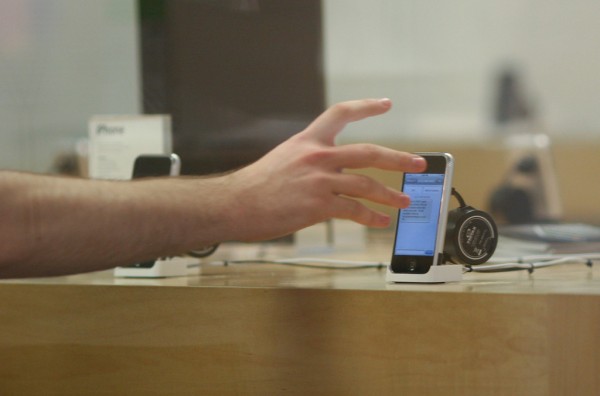U.S. reaches smartphone market peak, while the rest of the world keeps on going

Who would have guessed that it was time for the smartphone market to take a breath and slow down before the second half of 2012? Strategy Analytics released a report analyzing the U.S. smartphone market and shipments for Q2 2012, focusing on the two biggest smartphone operating systems, Android and iOS. The results make for an unexpected scenario: has the smartphone market reached its peak and if so, who’s the winning platform?
The Strategy Analytics report posts a decrease on smartphone shipment growth year-over-year with a 70.1 percent increase in 2011 and a 5.4 percent decrease for 2012, calling for a comparison with the report made available by IDC, which focuses on worldwide sales and market share. The differences between global results and those in the U.S. only suggest the U.S. market might have reached its peak, while worldwide smartphones are enjoying better sales.
According to Strategy Analytics, 23.8 million smartphones have shipped in Q2 2012, which is a 1.4 million decrease from the 25.2 million units sold in Q2 2011. As expected, RIM is the constant loser, with BlackBerry devices selling just 1.6 million compared to the 2.7 million sold last year. It lost operating system market share as well, down to 6.5 percent in 2012 compared to a better 10.5 percent last year in Q2 2011. RIM is expected by industry analysts and the public to fare worse both quarterly and annually, but Android isn't, and that’s the most surprising part of the report.
The Google-owned operating system has lost both in terms of shipments and operating system market share. Android has shipped 13.4 million units in Q2 2012, a 12.41 percent decrease from the 15.3 million units sold in Q2 2011 and its market share has followed the trend. Android had a 60.6 percent operating system market share in Q2 2011 and has lost 4.3 percentage points over the course of a year, now down to 56.3 percent share.
The surprise comes from iOS which benefitted from Android’s loss. iOS shipments have grown by 2 million units, from 5.9 million units in Q2 2011 to 7.9 million sold in Q2 2012, a 33.89 percent increase over the course of a year. iOS market share has increased as well, from 23.2 percent in Q2 2011 to 33.2 percent in Q2 2012, a 10 percentage point increase.
Two weeks ago, I wrote about Android and iOS market share according to Nielsen’s report, and those numbers are close to the ones posted by Strategy Analytics today. In June 2012, 51.8 percent of US smartphones were running Android, while 34.3 percent were powered by iOS. Comparing it to the 56.3 percent for Android and 33.2 percent for iOS from the Strategy Analytics report, a 4.5 percentage point variance can be seen. But there is only a 1.1 percentage point variance between the different iOS numbers.
Both reports end their measurements in June 2012, so the comparison between the two sets of numbers is completely valid, allowing for a conclusion to be drawn: reports are not always indicative of actual market state and there will be differences between them based on measurements. Comparing two sets of data should yield closer results, but it points out that’s not the case. There is always something else that’s overlooked: individual manufacturer shipments are not indicative of actual operating system's market share.
Apple sold 26 million iPhones in Q2 2012 compared to 20.4 million in Q2 2011, 5.6 million units more, but its operating system market share dropped from 18.8 percent in Q2 2011 by 1.9 percentage points to 16.9 percent in Q2 2012. That is indicative of worldwide decreasing market share, but back home the Cupertino, Calif.-based corporation is getting stronger. It simply doesn’t mean that a lower market share can be translated to select markets, especially the U.S. which is one of the mature ones.
Samsung has sold 50.2 million smartphones in Q2 2012, but Apple has only managed 26 million. Samsung has a 32.6 percent market share and Apple just 16.9 percent market share. The biggest Android smartphone manufacturer is increasing its market share, while the only iOS device manufacturer is seeing a decrease in Q2 2012. That’s in worldwide shipments and market share, so when compared to U.S. shipments and market share the numbers don’t translate.
54.2 percent of smartphone to smartphone buyers are favoring Android, while 33.5 percent buy an iOS device (iPhone). The numbers posted by comScore are showing that more people buy an Android smartphone when coming from a smartphone, while less smartphone owners are going for an iPhone. According to comScore Android is rising and iOS is decreasing. Furthermore, 61.5 percent of feature phone to smartphone buys are Android devices, with just 25.2 percent for iOS. That’s indicative of increasing smartphone share for Android from feature phone to smartphone upgrades and when compared to the numbers posted for iOS it can only account to an increase in market share for Android, but Strategy Analytics doesn’t agree with this assessment.
Is there reason for concern to Android and iOS smartphone manufacturers? The U.S. market has reached its peak if we’re to judge by Strategy Analytics numbers, while worldwide even more smartphones are sold. The problem comes from the fact that comScore and Strategy Analytics suggest two different things. comScore’s data reveals better Android and worse iOS numbers, but it’s not reflected by U.S. sales from Strategy Analytics report, so both give reason to doubt each other’s numbers and statistics.
If the U.S. smartphone market has reached its peak, it clearly doesn't show it.